Christine Heinrichs shares how living history farms in the U.S. preserve heritage poultry breeds. Stay tuned for her upcoming article on British living history breeds, such as the Dorking.
A flock of chickens brings a historic site to life. Visitors can’t resist the allure of chickens clucking in a run. At living history sites, historically accurate flocks are part of the program, and guides (or, as they’re more commonly called these days, “interpreters”) are knowledgeable about the often-rare breeds.

Old English gamecock named Hanky Dean. Photo courtesy of The Colonial Williamsburg Foundation
Historical sites, such as Colonial Williamsburg or Garfield Farm and Inn Museum, not only preserve the history of breeds, but act as conservators through careful breeding programs. Flocks of chickens, ducks, geese, and turkeys show visitors what heritage breeds look like, and how they fit into our agrarian past. Breeds such as Dominiques were weather-hardy and disease-resistant, making them important birds for an integrated agricultural future, as well as preservers of a cultural past.
Colonial Williamsburg
Colonial Williamsburg includes Nankins in its Rare Breeds Program, giving visitors the experience of what life was like in 18th century New England.
Nankins’ copper-colored bodies, with flashes of green and black tail feathers, are eye-catching and appealing to visitors, many of whom may never have seen anything but white chickens.
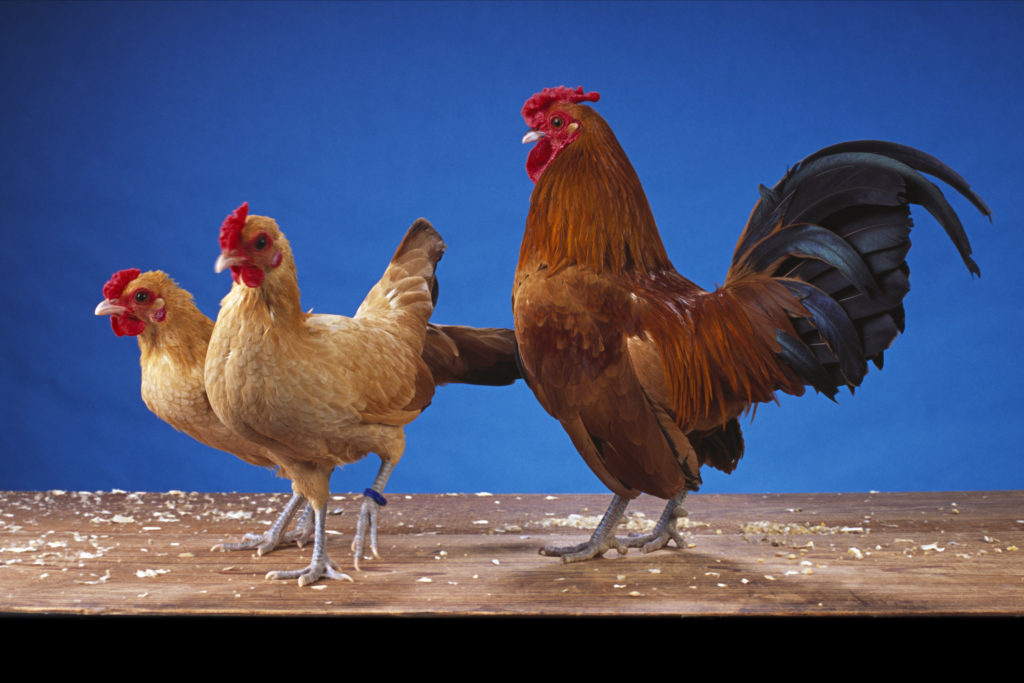
Nankin bantam hens and rooster. Nankin hens are noted for being good mothers. One breeder said, “They will try to hatch a rock!” Photo courtesy of The Colonial Williamsburg Foundation.
Nankins are thought to be one of the oldest breeds of true bantam chickens. They appear in English records prior to the 1500s, where they were popular bred birds until the mid-1800s. Even as they waned as an egg chicken, the hens were particularly valuable as brood chickens that would hatch out practically any egg put underneath them. They were brought to the U.S. with the pilgrims to be used as egg birds and gentle brooders, and could have lived in Williamsburg.
Nankins add authenticity to living history farms, and they also educate visitors about poultry in general.
“They attract peoples’ interest so you can lure them in and tell them more,” says Elaine Shirley, the site’s supervisor of rare breeds. “It’s important that folks realize that poultry had a use.”
Saving Heritage Livestock
Living history farms provide an opportunity to create breeding flocks of historic breeds that are now rare.
Colonial Williamsburg’s Rare Breeds Program includes cattle, sheep, and horses, as well as large fowl, such as Dominiques, Dorkings, and Old English Gamecocks, along with the Nankin bantams
“We use rare breeds because they have a story to tell and are part of our national heritage,” Shirley says. “The Coach and Livestock Department feels that by giving these animals some exposure, we can help their numbers and popularity increase.”

Colonial Williamsburg’s supervisor of rare breeds, Elaine Shirley, feeding Dominique chickens in the yard of the George Wythe fowl house. Dominiques are considered the first U.S. breed. Photo courtesy of The Colonial Williamsburg Foundation.
Life in Williamsburg
Colonial Williamsburg focuses on reproducing aspects of life in the area from 1699, when the state capital moved there from Jamestown, until 1780, when the capital moved to Richmond, Virginia. During this period, Virginia’s boundaries extended west to the Mississippi River and north to the Great Lakes. As the main trade center, Williamsburg was also a cultural and educational center. The College of William and Mary was founded there in 1693.
“Colonial Williamsburg is the largest living history museum in the world, showing visitors life on the eve of the American Revolution, and how that affected all classes of people,” Shirley says.
While this was a period of political turmoil for the young nation, agricultural practices and seasonal rhythms remained constant. Domesticated fowl and poultry provided food for the table, down feathers for the bedroom, and manure for the garden. Thomas Jefferson wrote to his granddaughter Ellen Wayles Randolph, asking, “How go on the Bantams? I rely on you for their care, as I do on Anne for the Algerine fowls. These varieties are pleasant for the table and furnish an agreeable diversification in our domestic occupations.”
Chickens in Williamsburg weren’t usually housed in chicken coops, but instead tended to live and roost in nearby orchards and pastures. During inclement weather, the birds could shelter in local kitchens and outbuildings.
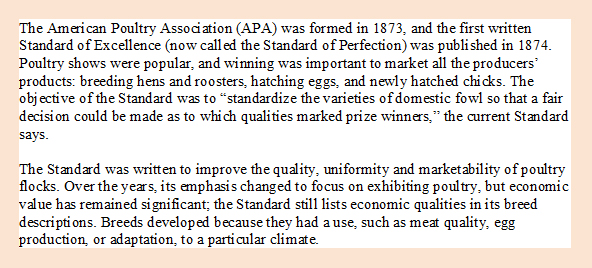
Williamsburg’s Flock Today
A flock of Nankins greets visitors to the poultry house at the George Wythe House. Wythe taught law in the colony, and his signature is the first one of the Virginia delegates to appear on the Declaration of Independence. Thomas Jefferson and John Marshall were among his law students.
Wythe’s flock would have included Polish, Dutch, Silkies, and Frizzles, along with Nankins, to show off to his friends.
“We interpret Nankins as a pleasure fowl for wealthier people,” Shirley says.
In 2019, Colonial Williamsburg’s Nankin flock numbers 29 birds, with 15 to 20 hens and nine or so roosters. Shirley is concentrating on breeding single combs, and has nearly eliminated rose combs from the flock. She lets some of the hens hatch a clutch every year to replace older birds, creating a mixed-age flock.
Williamsburg’s Nankins live up to their reputation of having a mild temperament. Shirley explains, “They are so friendly, I practically have to kick them out of the way.”
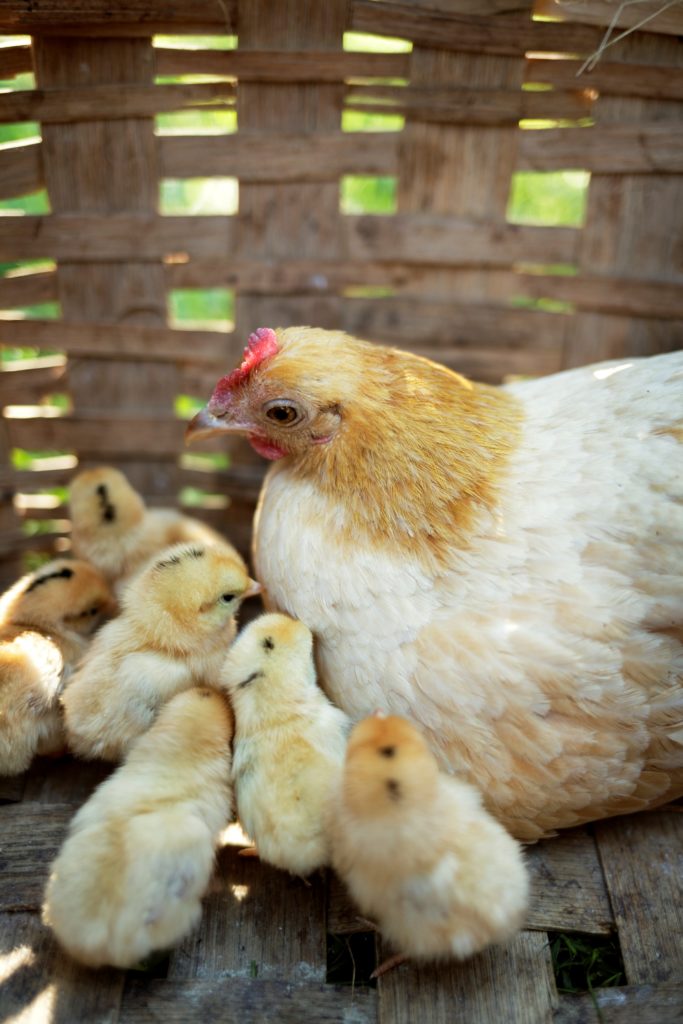
Nankin bantam hens and chicks. Photo courtesy of The Colonial Willaimsburg Foundation.
Large estates of the colonial period would’ve kept Nankins as broody hens to hatch pheasant and quail. The Williamsburg flock hatched some quail eggs for a local woman who had fertile eggs but no incubator.
Shirley credits Mark Fields and Bob Hawes with helping her start the flock. Fields wrote a book about Nankins, The Nankin Bantam: A Rare and Ancient Fowl, in 2006. However, it’s now out of print and difficult to find. Hawes recommended to Shirley that she keep Nankins as the historically accurate breed, and Fields donated his Nankins to get the flock started.
Visiting Classrooms
Outreach is part of Colonial Williamsburg’s educational mission, and Shirley often takes Nankins along on classroom trips and for other school visits.
“When I give chicken talks, Nankins are the ones I bring with me,” she says. “They’re so easy to carry and so well-behaved.”
The Colonial Williamsburg flock also provides hatching eggs to other breeders who are dedicated to keeping the Nankin breed vigorous. Shirley has given hatching eggs to 4-H Club leaders and others across the region over the years. The 4-H Club students often show their Nankins. She’s always happy to send eggs to those who appreciate them.
“They’re wonderful little chickens,” she says. “I’m thankful we got them.”
Garfield Farm Inn and Museum
Other historic sites also use chickens and other poultry as part of their interpretive missions. Garfield Farm, in Kane County, Illinois, is playing an important role in helping recover the Java chicken, once a popular large breed bird.
The farm was started in 1841 by Timothy Powers Garfield, who moved west from his birthplace in Vermont. Because the farm was originally located on a stagecoach route, Garfield started an inn to serve travelers, and needed to raise crops and livestock that could feed up to 59 guests at a time. As the railroad eroded stagecoach travel, Garfield shifted the focus of the farm to a dairy business in the 1850s. His granddaughter Elva Ruth Garfield donated the 163 acres, family home, and farm buildings to create Garfield Heritage Society Inc. in 1977.
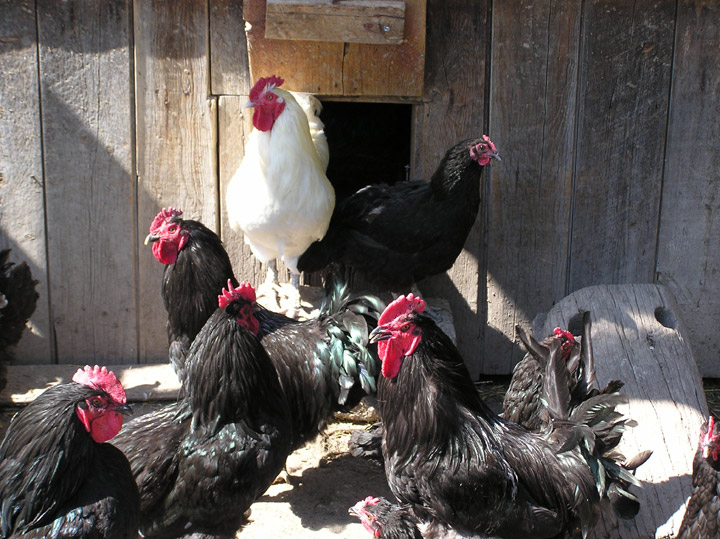
The white Java variety emerged naturally from Garfield Farm’s breeding program, while the auburn variety appeared later. Photo courtesy of Garfield Farm.
The current museum keeps flocks of Java chickens in addition to Narragansett turkeys and Pilgrim geese. Pilgrim geese aren’t an historical breed, but they do remind visitors that geese were commonly kept fowl on many U.S. farms
The second oldest chicken breed developed in the U.S., the ancestors of the Java were reported to have come from East Asia, possibly even from the island of Java itself. Records show that they were bred in the U.S. sometime between 1835 and 1850, and were intended to be a large homesteading bird used mostly as a meat chicken. The black Java strain was used in the development of both the Plymouth Rock and Jersey Giant breeds, while the auburn Java variety contributed genes to the Rhode Island Red.
Variants include black, mottled, white and auburn, though only the black and mottled Javas are currently recognized by the APA Standard of Perfection.
While the bulk of the Garfield Museum’s flock of Javas are the black and white varieties, an occasional brown or auburn chick hatches, reminding us that these genetic variations, once quite popular, still lurk in their genetic matrix.

Garfield Farm’s Narragansett turkeys and black and white Java chickens live together on the farm in Illinois. Photo courtesy of Garfield Farm.

List of Other Living History Farms
Living history farms are important sources of historical information brought to life by talented and dedicated historical interpreters. They preserve remnants of our historical past, as well as keep older livestock and heritage breeds alive.
Here are several farms around the country that you can visit to see how we lived and what we bred.
Plimouth Plantation, Massachusetts: Dorking chickens
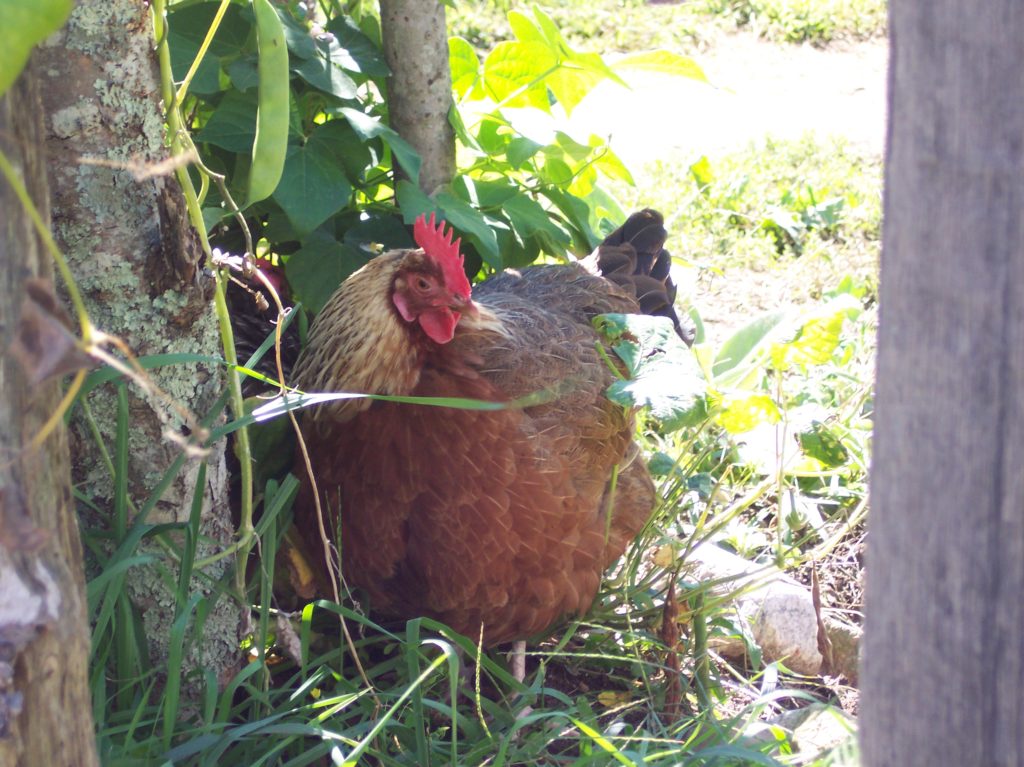
Dorkings take their name from an English market town, but the five-toed fowl were popular in southern England in the 1600s. Plimouth Plantation in Massachusetts keeps Dorkings, a breed English settlers brought with them. Photo by Christine Heinrichs.
Frontier Culture Museum, Virginia: Dorking, Spitzhauben, and Polish chickens
Missouri Town 1855, Missouri: Cochin, Dominique, White-faced Black Spanish, silver Spangled Hamburg, Buff and Partridge Cochin, and brown Leghorn (also called Italian) chickens
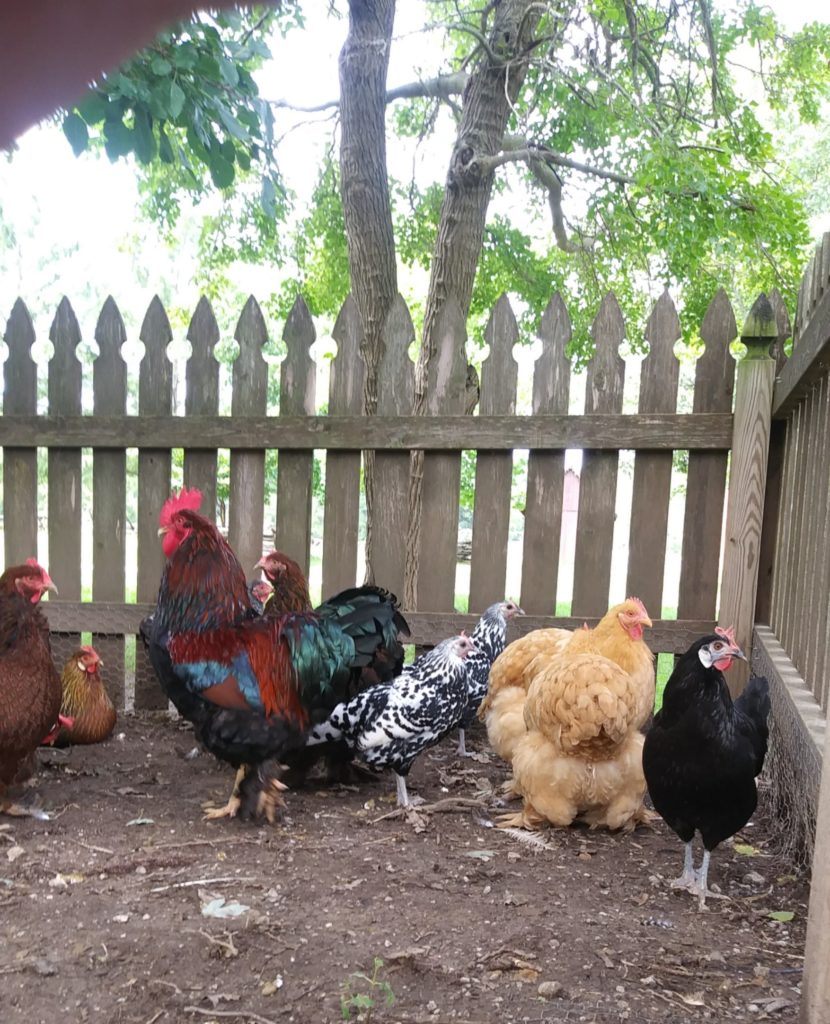
Missouri Town 1855 keeps a mixed flock of Buff and Partridge Cochins, brown Leghorns, silver Spangled Hamburgs, Dominique, and White-faced Black Spanish. Photo by Tim Lunceford.
The Homeplace in Land Between the Lakes, Tennessee: Dominique chickens and black Cayuga Ducks.
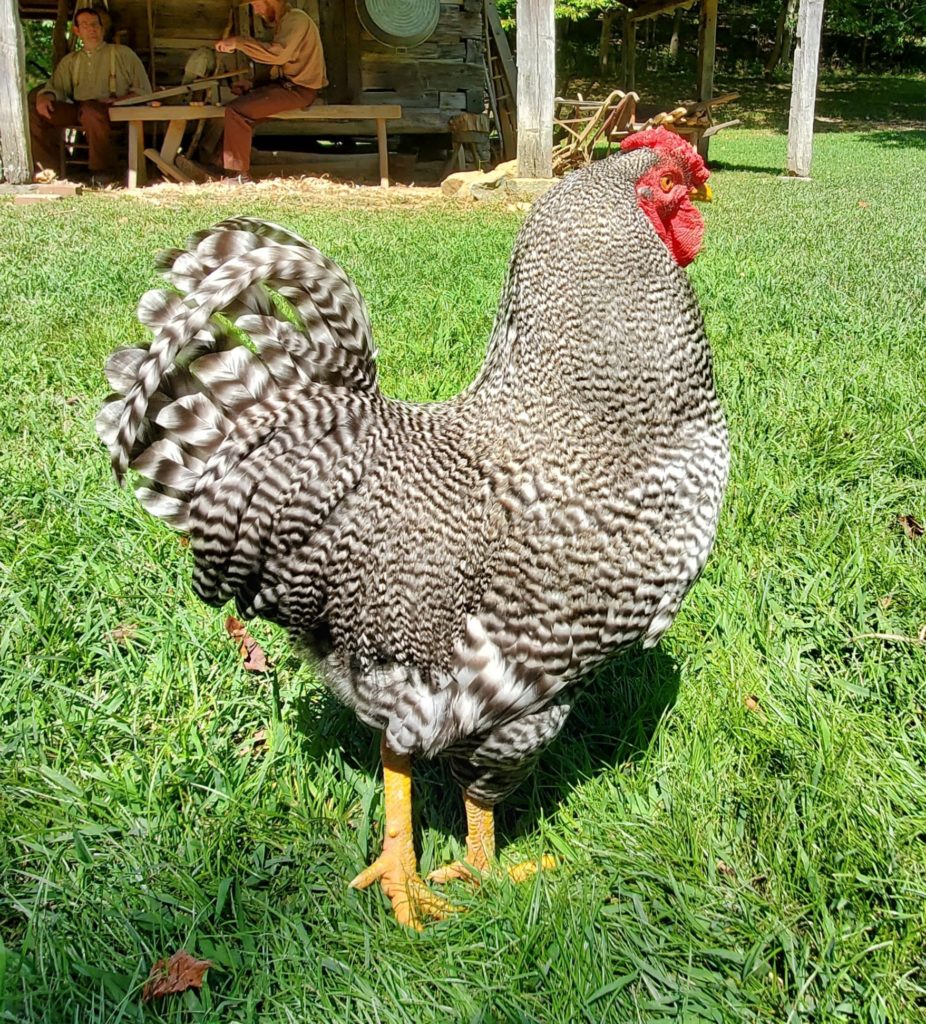
Homeplace 1850s is a working farm and living history museum in Tennessee that keeps a flock of Dominiques. Photo by Wendy Levier.
Christine Heinrichs writes from her home on California’s Central Coast. She keeps a backyard flock of a dozen hens, eight large fowl of various breeds, and four bantams.
Her book, How to Raise Chickens, was first published in 2007, just as the local food movement was starting to focus attention on the industrial food system. Backyard chickens became the mascot of local food. The third edition of How to Raise Chickens was published in January 2019. The Backyard Field Guide to Chickens was published in 2016. Look for them in the Community Chickens online shop, or in Tractor Supply stores.
Heinrichs has a bachelor’s in journalism from the University of Oregon, and belongs to several professional journalism and poultry organizations.













1 Comment
Here at the Colonial Pennsylvania Plantation, an 18the century living history farm museum in Ridley Creek State Park, Media PA, we have Dominiques, Nankins, Silver Dorkings, Silkies, Narrangassett and Bourbon turkeys. Oh and Pilgrim geese!